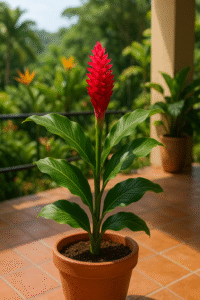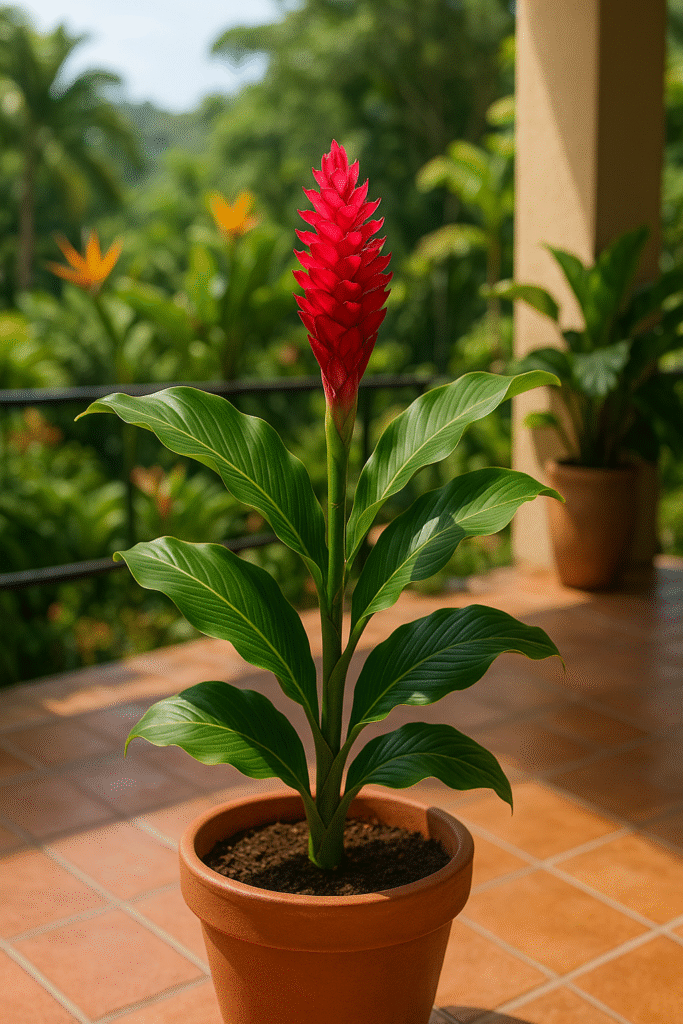The Red Ginger (Alpinia purpurata), also known as red ginger lily, is a tropical plant admired worldwide for its vibrant flowers and lush foliage. Native to the Pacific Islands, Malaysia, and parts of the Caribbean, it has become a favorite in ornamental gardens and tropical landscaping projects. Its striking red bracts, often mistaken for petals, surround the small white flowers, creating an exotic visual that draws attention anywhere it grows.
In this article, you’ll discover 7 fascinating facts about Red Ginger, along with tips for growing and caring for this stunning plant in your own garden.
1. Red Ginger Is Not Just About the Color
Although the name suggests a single color, the Red Ginger plant can also be found in pink and even white varieties. The vibrant red variety remains the most popular for ornamental purposes because of its bold, eye-catching appearance. The “flowers” people admire are actually colorful bracts — specialized leaves that protect the small, true flowers inside.
These bracts can last for weeks, making Red Ginger one of the best choices for cut flower arrangements and floral displays.
2. It’s a Symbol of Exotic Elegance
In tropical landscaping, Red Ginger is often used as a focal point. Its tall stems and bright blooms stand out against the lush green backdrop of other plants. In Hawaiian culture, it symbolizes beauty, strength, and good fortune, and it is commonly used in leis and ceremonial decorations.
Gardeners value it not just for its looks but also for the touch of the exotic it brings to outdoor spaces. Even in colder climates, it can be grown in pots and brought indoors during winter, maintaining its tropical charm.
3. Red Ginger Has Impressive Longevity as a Cut Flower
One of the most fascinating features of the Red Ginger flower is how long it lasts after being cut. With proper care, these blooms can stay fresh for up to three weeks in a vase, making them a favorite among florists.
This durability comes from the plant’s thick bracts, which protect the tiny flowers from drying out. For best results, stems should be cut early in the morning and placed immediately in water.
4. A Natural Pollinator Magnet
Red Ginger attracts bees, butterflies, and hummingbirds thanks to its bright color and nectar-rich flowers. In tropical gardens, it plays an important role in supporting biodiversity. By planting Red Ginger alongside other flowering tropical plants, you can create a lively and pollinator-friendly environment.
5. Easy to Grow in the Right Conditions
Although it looks exotic and rare, Red Ginger is relatively easy to grow in suitable climates. It thrives in warm, humid environments with partial shade and well-draining soil.
Basic growing tips:
-
Light: Prefers filtered sunlight or partial shade.
-
Water: Keep the soil consistently moist but not waterlogged.
-
Temperature: Best in temperatures above 15°C (59°F).
-
Fertilizer: Apply a balanced fertilizer during the growing season to encourage healthy growth and abundant blooms.
In cooler regions, it can be grown in containers and moved indoors during the colder months.
6. Red Ginger Has Culinary and Medicinal Relatives
While Alpinia purpurata is mainly ornamental, it belongs to the same family (Zingiberaceae) as edible ginger (Zingiber officinale) and other medicinal gingers. Some traditional cultures use parts of the plant in herbal remedies, although it is not commonly consumed like edible ginger.
The leaves and bracts have been used in certain Pacific Islands for wrapping food or for decorative purposes in traditional cooking.
7. It Can Grow Quite Tall
A mature Red Ginger plant can reach heights of 1.5 to 2.5 meters (5–8 feet), making it a dramatic addition to any garden. Its height, combined with large green leaves and vivid bracts, creates a striking visual effect.
Because of its size, it’s often planted at the back of garden beds or used as a natural privacy screen. When grown in the right conditions, it can bloom year-round, especially in tropical and subtropical regions.
How to Incorporate Red Ginger into Your Garden Design
-
Tropical Borders: Pair with heliconias, bird of paradise, and other tropical flowers for a lush, layered look.
-
Container Gardening: Use large decorative pots for patios and balconies.
-
Cut Flower Garden: Plant a small group specifically for floral arrangements.
-
Around Water Features: Red Ginger’s bold colors complement ponds, fountains, and pools beautifully.
Conclusion
The Red Ginger is more than just a plant — it’s a symbol of tropical elegance, a long-lasting cut flower, and a pollinator-friendly addition to the garden. Whether you live in a tropical region or grow it in containers in cooler climates, it will reward you with months of color and beauty.
From its cultural significance to its easy-care nature, the Red Ginger remains one of the most captivating tropical flowers available to gardeners today. If you’re looking to add vibrant color, height, and exotic charm to your outdoor space, the Red Ginger plant is an unbeatable choice.

🪴 Elevate your plant display with the stylish
Plant Basket with Stand. Featuring a sturdy jute and cotton rope design in black and beige stripes with a bamboo stand, this 10-inch indoor planter adds a modern touch to any room while keeping your plants secure and beautifully presented.
🌿 Discover the bold flavor and health benefits of
Culantro, the tropical herb that’s full of surprises.
Learn how to grow, use, and enjoy this unique plant in your kitchen and garden.

